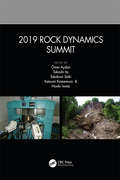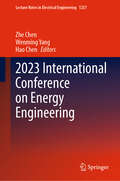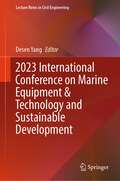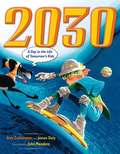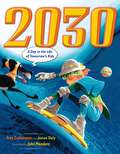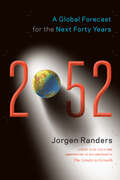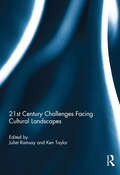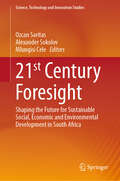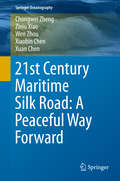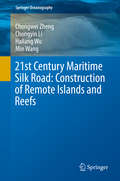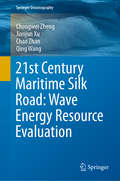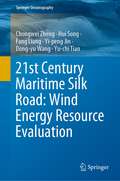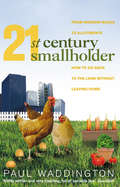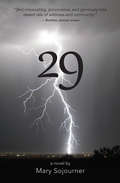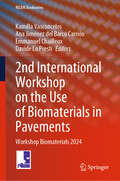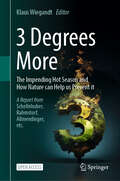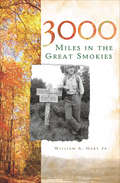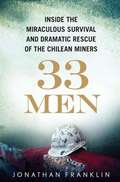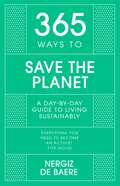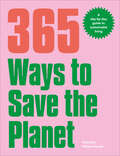- Table View
- List View
2019 Rock Dynamics Summit: Proceedings of the 2019 Rock Dynamics Summit (RDS 2019), May 7-11, 2019, Okinawa, Japan
by Ömer Aydan Takashi Ito Takafumi Seiki Katsumi Kamemura Naoki IwataRock dynamics has become one of the most important topics in the field of rock mechanics and rock engineering, and involves a wide variety of topics, from earthquake engineering, blasting, impacts, failure of rock engineering structures as well as the occurrence and prediction of earthquakes, induced seismicity, rock bursts to non-destructive testing and explorations. Rock dynamics has wide applications in civil and infrastructural, resources and energy, geological and environmental engineering, geothermal energy, and earthquake hazard management, and has become one of the most topical areas. 2019 Rock Dynamics Summit contains 8 keynote addresses and 128 regular full papers that were presented at the 2019 Rock Dynamics Summit (2019 RDS, Okinawa, Japan, 7-11 May 2019), a specialized conference jointly organized by the Rock Dynamics Committee of the Japanese Society of Civil Engineers (JSCE-RDC), the Japanese Society for Rock Mechanics (JSRM), and which was supported by the International Society for Rock Mechanics and Rock Engineering (ISRM) and the Turkish National Society for Rock Mechanics (TNSRM). The contributions cover a wide range of topics on the dynamic behavior of rock and rock masses and scientific and engineering applications, and include: - Laboratory tests on Dynamic Responses of Rocks and Rock Masses / Fracturing of Rocks and Associated Strong Motions- Estimation Procedures and Numerical Techniques of Strong Motions Associated with the Rupture of Earth’s Crust and Some Strong Motion- Dynamic Response and Stability of Rock Foundations, Underground Excavations in Rock, Rock Slopes Dynamic Responses and Stability of Stone Masonry Historical Structures and Monuments- Induced Seismicity- Dynamic Simulation of Loading and Excavation- Blasting and machinery induced vibrations- Rockburst, Outburst, Impacts- Nondestructive Testing Using Shock Waves- Case Histories of Failure Phenomenon in Rock Engineering 2019 Rock Dynamics Summit contains the state-of-the-art in rock dynamics, and will be invaluable to professionals and academics interested in the latest advances in new techniques for experiments, analytical and numerical modelling as well as monitoring in dynamics of rocks and rock engineering structures.
2023 International Conference on Energy Engineering (Lecture Notes in Electrical Engineering #1257)
by Zhe Chen Hao Chen Wenming YangThis book contains the selected proceedings of the 2023 International Conference on Energy Engineering, held in Xi'an, China, December 15-17, 2023. The conference explores advances and practical applications in energy research and engineering, and delves into innovative approaches in four specialized tracks: New Transportation Energy, Power and Energy, Applied Thermal Energy, and Oil and Natural Gas Engineering. It explores strategies for accelerating the transition to renewable energy, optimizing power systems, harnessing thermal energy, and advancing oil and gas engineering practices. It benefits from a wealth of knowledge shared by academics and practitioners, fostering cross-disciplinary collaboration. The latest findings in electric vehicles, smart grids, thermal systems, and reservoir engineering will be explored to find solutions that promote sustainability, efficiency, and environmental stewardship.
2023 International Conference on Marine Equipment & Technology and Sustainable Development (Lecture Notes in Civil Engineering #375)
by Desen YangThis book contains original, peer-reviewed, and selected research papers that were presented at the 2023 International Conference on Marine Equipment & Technology and Sustainable Development, which took place in Beijing, China on April 1st 2023. The papers cover a range of topics, including but not limited to: the vision and goals of building a maritime community with a shared future, marine machinery and transportation, marine ecology, environmental protection and conservation, marine safety, future ships and marine equipment, marine engineering, marine information and technology, maritime policy, and global governance.The papers included in this volume provide the latest findings on methodologies, algorithms, and applications in marine equipment and technology, as well as sustainable development. As a result, this book is an invaluable resource for researchers, engineers, and university students who are interested in these fields.
2030: A Day In The Life Of Tomorrow's Kids
by James Daly Amy ZuckermanGlobal events and new technology change how we live from moment to moment. So, what will our world be like in twenty years? Come take a look as futurists Amy Zuckerman and James Daly examine what a kid?s daily life might be like in the year 2030. Inspired and informed by trends and scientifi c and technological research, 2030 is not only a peek at some cool future gadgets (talking dog collars, cars that drive themselves), but also a thoughtful examination of how our lives might be impacted as we adjust to environmental change.
2030: A Day in the Life of Tomorrow's Kids
by James Daly Amy ZuckermanWinner of the 2012 Grand Canyon Reader Award for a Non-fiction bookGlobal events and new technology change how we live from moment to moment. So, what will our world be like in twenty years? Come take a look as futurists Amy Zuckerman and James Daly examine what a kid?s daily life might be like in the year 2030. Inspired and informed by trends and scientifi c and technological research, 2030 is not only a peek at some cool future gadgets (talking dog collars, cars that drive themselves), but also a thoughtful examination of how our lives might be impacted as we adjust to environmental change.
2052: A Global Forecast for the Next Forty Years
by Jorgen RandersWith clarity, conscience, and courage, global-systems pioneer Jorgen Randers and his distinguished contributors map the forces that will shape the next four decades.Forty years ago, The Limits to Growth study addressed the grand question of how humans would adapt to the physical limitations of planet Earth. It predicted that during the first half of the 21st century the ongoing growth in the human ecological footprint would stop-either through catastrophic "overshoot and collapse"-or through well-managed "peak and decline."So, where are we now? And what does our future look like? In the book 2052, Jorgen Randers, one of the coauthors of Limits to Growth, issues a progress report and makes a forecast for the next forty years. To do this, he asked dozens of experts to weigh in with their best predictions on how our economies, energy supplies, natural resources, climate, food, fisheries, militaries, political divisions, cities, psyches, and more will take shape in the coming decades. He then synthesized those scenarios into a global forecast of life as we will most likely know it in the years ahead.The good news: we will see impressive advances in resource efficiency, and an increasing focus on human well-being rather than on per capita income growth. But this change might not come as we expect. Future growth in population and GDP, for instance, will be constrained in surprising ways-by rapid fertility decline as result of increased urbanization, productivity decline as a result of social unrest, and continuing poverty among the poorest 2 billion world citizens. Runaway global warming, too, is likely.So, how do we prepare for the years ahead? With heart, fact, and wisdom, Randers guides us along a realistic path into the future and discusses what readers can do to ensure a better life for themselves and their children during the increasing turmoil of the next forty years.
21st Century Challenges Facing Cultural Landscapes
by Juliet Ramsay and Ken TaylorThrough stories of diverse landscapes from around the world, this book captures human cultures and their land use practices in the environments they inhabit. The chapters cover topics from heritage in the 21st Century, appreciating and safeguarding values while facing challenges wrought by change.This title will lead readers through fascinating stories of landscapes and people. We learn of the physical and spiritual structure of rice terraces of the Honghe Mountains in China maintained by following a 1300 year sustainable practice of water allocation, while the colonial tea plantations of the Sri Lankan highlands are managed by Indian Tamils who now seek tourism as a means of additional income. Sustainable agricultural methods in the USA are being introduced to prevent landscape loss while in Australia a challenge confronting family farms is progressing to rural industrialisation. Challenges are further outlined in the mythical story of Finland's Saint Henrik pilgrimage and in the intangible Ui-won gardens of Korea. The huge challenge for Japan's landscapes is the legacy from fierce natural 21st Century disasters while in Australia's Dampier Archipelago, an avoidable yet brutal development on a unique Aboriginal rock sculptured landscape highlights serious concerns about heritage governance. These remarkable stories of landscapes and their management are inseparable from the communities that inhabit them. This book was originally published as a special issue of Landscape Research.
21st Century Foresight: Shaping the Future for Sustainable Social, Economic and Environmental Development in South Africa (Science, Technology and Innovation Studies)
by Alexander Sokolov Ozcan Saritas Mlungisi CeleUsing a new methodology for foresight studies, this book presents new findings and policy recommendations to improve living conditions and make progress toward achieving the Sustainable Development Goals (SDGs). Using the case of South Africa, the respective chapters show how social and economic challenges can be addressed in an inclusive and sustainable way. The book also provides guidelines for practitioners by introducing them to cutting-edge ways of formulating Science, Technology, and Innovation (STI) policies. The new foresight methodology uses a combination of qualitative and quantitative methods, including horizon scanning and scenario planning, as well as big data analysis, scientometric and semantic methods. The innovative approaches developed throughout the book are subsequently demonstrated using a national foresight study in South Africa. The outputs and outcomes generated by the study can be used to inform the identification and selection of priorities for the next decadal plan for STI. The book offers a valuable asset for emerging and developing economies in Africa and around the world in terms of tackling the grand challenges of the 21st century, such as water, food, energy, climate change, health and education.
21st Century Maritime Silk Road: A Peaceful Way Forward (Springer Oceanography Ser.)
by Chongwei Zheng Ziniu Xiao Wen Zhou Xiaobin Chen Xuan ChenThis book focuses on understanding the characteristics of the marine environment; overall characteristic of the marine resources (especially the marine new energy) and their current utilization; important routes, channels, and ports; and the Maritime Silk Road from the perspective of international law. It also discusses the significance and opportunities of the Maritime Silk Road initiative, analyzes the challenges involved in the construction of the Maritime Silk Road and provides corresponding countermeasures. Based on the above research, this book also proposes to construct a comprehensive application platform for the Maritime Silk Road that will be a practical tool for decision-making. <P><P> This book is one of the series publications on the 21st century Maritime Silk Road (shortened as “Maritime Silk Road”). This series publications cover the characteristics of the marine environment and marine new energy, remote islands and reefs construction, climate change, early warning of wave disasters, legal escort, marine environment and energy big data construction, etc. contributing to the safe and efficient construction of the Maritime Silk Road. It aims to improve our knowledge of the ocean, thus to improve the capacity for marine construction, enhance the viability of remote islands and reefs, ease the energy crisis and protect the ecological environment, improve the quality of life of residents along the Maritime Silk Road, and protect the rights, interests of the countries and regions participating in the construction of the Maritime Silk Road. It will be a valuable reference for decision-makers, researchers, and marine engineers working in the related fields.
21st Century Maritime Silk Road: Construction of Remote Islands and Reefs (Springer Oceanography)
by Min Wang Chongwei Zheng Chongyin Li Hailang WuThis book focuses on the construction of remote islands and reefs in the Maritime Silk Road. Firstly, it analyzes the functions, necessity and difficulties of the construction of remote islands and reefs; then provides corresponding countermeasures. According to the urgent demand of electricity and freshwater, it focus on wave and offshore wind energy evaluation of the important remote islands and reefs of the Maritime Silk Road, providing reference for the choice of location of power plants, daily operation and long term plan of wave/wind power generation. Several important key points are selected in the case study to realize their electricity and freshwater self-sufficiency and thus to improve their viability. This book also presents the marine characteristics (especially hazardous elements) under the demands of island runway construction and marine new energy development, to promote safe and efficient implementation of the remote islands and reefs construction. This book is one of the series of publications on the 21st Century Maritime Silk Road (shortened as “Maritime Silk Road”). It covers the characteristics of the marine environment and marine new energy, remote islands and reefs construction, climate change, early warning of wave disasters, legal escort, marine environment and energy big data construction, etc. contributing to the safe and efficient construction of the Maritime Silk Road. It aims to improve our knowledge of the ocean, thus to improve the capacity for marine construction, enhance the viability of remote islands and reefs, ease the energy crisis and protect the ecological environment, improve the quality of life of residents along the Maritime Silk Road, and protect the rights, interests of the countries and regions participating in the construction of the Maritime Silk Road. It will be a valuable reference for decision-makers, researchers, and marine engineers working in the related fields.
21st Century Maritime Silk Road: Wave Energy Resource Evaluation (Springer Oceanography)
by Qing Wang Chongwei Zheng Jianjun Xu Chao ZhanThis book focuses on the evaluation of wave energy in the Maritime Silk Road. Firstly, it compares wave energy and other main energy sources, and then discusses the various disadvantages. It also presents the current research and the difficulties of wave energy evaluation, and systematically analyzes the climatic characteristics of the wave energy, including the temporal–spatial distribution and climatic trend of a series of key factors (e.g. wave power density, availability, richness, stability, energy direction, energy storage). It then describes the design of a short-term forecasting scheme and a long-term projection scheme of wave energy suitable for the Maritime Silk Road, to serve as a plan for the daily operation and long-term development of wave energy. Further, it highlights the wave energy analysis and decision-making in the context of the remote islands and reefs, using Sri Lanka is taken as a case study. Lastly, it presents the first wave energy resource dataset for the Maritime Silk Road.This book is one of a series of publications on the 21st century Maritime Silk Road (shortened as “Maritime Silk Road”) that covers the characteristics of the marine environment and marine new energy, remote islands and reef construction, climate change, early warning of wave disasters, legal escort, marine environment and energy big data construction, contributing to the safe and efficient construction of the Maritime Silk Road. It aims to improve our knowledge of the ocean, and so improve the capacity for marine construction, enhance the viability of remote islands and reefs, ease the energy crisis and protect the ecological environment and improve the quality of life of residents along the Maritime Silk Road, as well as to protect the rights, and interests of the countries and regions participating in the construction of the Maritime Silk Road. This book is a valuable reference resource for decision-makers, researchers, and marine engineers working in the related fields.
21st Century Maritime Silk Road: Wind Energy Resource Evaluation (Springer Oceanography)
by Chongwei Zheng Hui Song Fang Liang Yi-peng Jin Dong-yu Wang Yu-chi TianThis book aims to establish a wind energy evaluation system, to provide scientific reference for site selection, daily operation and long-term planning of wind power generation, thus to make contribution to breaking the shackles of power shortage. Firstly, it presents the advantages and disadvantages of offshore wind power, then further discusses about the status quo and challenges for wind power programs along the Maritime Silk Road and offer suggestions. A wind energy evaluation system was proposed with the Maritime Silk Road as a case study, including climatic features of wind power (temporal-spatial distribution), long-term climatic trend and mechanism, short-term forecast of wind energy, mid- and long-term projection of wind energy, technology of wind energy evaluation on key point or vital region and offshore wind energy dataset construction, to provide systematic and scientific reference for wind power evaluation and utilization.This book is one of the series of publications on 21st century Maritime Silk Road (shortened as “Maritime Silk Road”). It covers the characteristics of the marine environment and marine renewable energy, remote islands and reefs construction, climate change, early warning of wave disasters, legal escort, marine environment and energy big data construction, etc., contributing to the safe and efficient construction of the Maritime Silk Road. It aims to improve our knowledge of the ocean, thus, to improve the capacity for marine construction, enhance the viability of remote islands and reefs, ease the energy crisis and protect the ecological environment, improve the quality of life of residents along the Maritime Silk Road, and protect the rights, interests of the countries and regions participating in the construction of the Maritime Silk Road. It is a valuable reference for decision-makers, researchers, and marine engineers working in the related fields.
21st-Century Smallholder: From Window Boxes To Allotments: How To Go Back To The Land Without Leaving Home
by Paul WaddingtonAchieving genuine self-sufficiency of the kind described in John Seymour's classic guide is sadly beyond the vast reach of the urban majority today. Few have the space, and for those few there are comprehensive guidebooks. But where do the rest of us look for the answers to questions like how much effort does it really take to grow your own food? Is beekeeping difficult? Is solar power really worth the bother?From a small terraced house in the middle of a big city, Paul Waddington has made it his business to find out, and while trying it himself, has created a practical and absorbing guidebook along the way. It includes easy-to-read lists, tables, personal anecdote, and stunning illustrations, and more importantly demystifies the subject with practical tips that get to the heart of the matter to show you how you can enjoy the fulfilling aspects of the smallholding life without the hassle and expense of 'going all the way'. If you want to go back to the land without leaving home, this is the perfect guide.
29
by Mary Sojourner"Ever-ascending Sojourner cooks up wrenching sorrow and hilarious banter, environmental and moral conundrums, magnetizing characters, and a place of transcendent beauty in this intoxicating, provocative, and gloriously told desert tale of wildness and community, unexpected bonds and deep legacies, trauma and healing."-Donna Seaman, BOOKLIST (starred review) "This standout ecological novel from Arizona author Sojourner (Going Through Ghosts) features picturesque prose, a vivid western setting, and sharply drawn characters."-PUBLISHERS WEEKLY (starred review)"In Nell Walker, Mary Sojourner has created a character who discovers-in her own desperate way-the simple beauty in the interconnectedness of the natural world and the complexities we heap upon it. Written with passion and humor, 29 takes the reader on a journey of hope, humanity, and love."-Jana Richman, author of Riding in the Shadows of Saints, The Last Cowgirl, and The Ordinary Truth"29 is at the intersection of a local road to Nowhere and an interstate to Everywhere. Certainly Mary's prose and storytelling is crystalline and lovely, a kind of geode broth, filled with light and piquancy."-David Kranes, author of The Legend's Daughter and The National Tree"Sojourner's desert eyes not only see but transform what others dismiss and ignore. She brings readers deep into the dust and sparkle of the Mojave, forcing the reader to hear the people of the desert-their stories, their sorrows, and their fierce and fragile loves. 29 holds the ragged weeping desert open, then kisses closed her wounds. A love letter to what we frequently deem unloveable, 29 is a wide-armed triumph of hope."-Laraine Herring, author of Ghost Swamp Blues and Writing Begins with the Breath"This is a story that will stay with the readers and, perhaps, bring them home to their own place, and the importance of fighting for what you love."-Susan Lang, author of the Mojave novels trilogy"The language is sharp as a butcher's blade, the dialogue rings true and hard, and the story cuts deeply into its reader."-H. Lee Barnes, author of Cold Deck, The Lucky, and Car Tag"Sojourner's new novel, much like the desert landscapes in which it is set, will never speak to those who see the Mojave as an annoying blur between L.A. and Vegas, but those adventurous enough (or lost enough) to wander off I-15 will find a world bursting with fragile beauty, tenacious life, and rock hard truth."-Giles Carwyn, author of Queen of Oblivion
2nd International Workshop on the Use of Biomaterials in Pavements: Workshop Biomaterials 2024 (RILEM Bookseries #58)
by Emmanuel Chailleux Davide Lo Presti Kamilla Vasconcelos Ana Jiménez del Barco CarriónThis volume highlights the latest advances, innovations, and applications in biomaterials for road pavements, as presented by leading international researchers and engineers at the 2nd International Workshop on the Use of Biomaterials in Pavements, held in São Paulo, Brazil on September 23-24, 2024. It covers a diverse range of topics concerning the roadmap for biomaterial integration in road materials, including: bio-based binders and additives, recycled biomass and waste materials, environmental impact and sustainability assessment, recyclability and circular economy, testing methods and performance evaluation. The contributions, which were selected by means of a rigorous international peer-review process, present a wealth of exciting ideas that will open novel research directions and foster new multidisciplinary collaborations.
3 Degrees More: The Impending Hot Season and How Nature Can Help Us Prevent It
by Klaus WiegandtThis open access book describes in detail what life on this planet would be like if its average surface temperature were to rise 3 degrees Celsius above the preindustrial level. On this basis, the book argues that it is imperative to keep this temperature rise below 2 degrees Celsius. It then lays out a detailed plan of what politically feasible, cost-effective measures should now be taken to achieve this goal. In this context, the book provides detailed discussions of climate finance, climate education and nature-based solutions. The book has been translated into English from the original German version published in 2022, and contains an original foreword and preface.
3-D Seismic Interpretation
by M. Bacon R. Simm T. RedshawThis book introduces geophysicists and geologists to the technique of interpreting 3-D seismic data. The topics it covers include basic structural interpretation and map-making; the use of 3-D visualization methods; interpretation of seismic amplitudes; the generation and use of AVO and acoustic impedance datasets; and time-lapse seismic mapping. Written by professional geophysicists with many years of working experience in the oil industry, the book will be indispensable for graduate students, researchers, and new entrants into the petroleum industry.
3000 Miles in the Great Smokies
by William A. Hart Jr.A hiking memoir by &“a man whose soul is held in thrall by remote places in the Smokies where . . . rising trout and fog-laden valleys rule supreme&” (Jim Casada, The Literature of Hiking in the Smokies). Bill Hart has hiked, camped and fished in the Great Smoky Mountains National Park for more than forty years. In over three thousand miles of walking, he has recorded experiences and impressions that will delight readers of all ages. Whether exploring some of the most remote sections of the Smokies, angling for trout, meeting mountain folk, or marveling at the flora and fauna around him, Bill has a gift for heartfelt storytelling and a wealth of knowledge to share about the park. Join him for an unforgettable journey through a beloved national treasure. Includes photos &“[A] collection of essays and journal entries of over 40 years of hiking, camping and exploring in the Great Smoky Mountain National Park.&” —Go Knoxville &“A compilation of thoughts and reminiscences of his wonderful days and nights there.&” —Smoky Scout&’s Hiking Adventures
33 Men: Inside the Miraculous Survival and Dramatic Rescue of the Chilean Miners
by Jonathan Franklin<p>Having had unparalleled access to the Chilean mine disaster, award-winning journalist Jonathan Franklin takes readers to the heart of a remarkable story of human endurance, survival, and historic heroism. <p><i>33 Men</i> is the groundbreaking, authoritative account of the Chilean mine disaster, one of the longest human entrapments in history. Rushing to the scene when the miners were discovered, Franklin obtained a coveted "Rescue Team" pass and reported directly from the front lines of the rescue operation, beyond police controls, for six weeks. Based on more than 110 intimate interviews with the miners, their families, and the rescue team, Franklin's narrative captures the remarkable story of these men and women, in details shocking, beautiful, comedic, and heroic. <p>Gripping and raw with never-before-revealed details, <i>33</i> Men is a true story that reads like a thriller.</p>
365 Ways to Live Green
by Diane Gow McDildaIt's the choices we make every day that affect our world tomorrow365 Ways to Live Green offers an extended list of opportunities to live with more care for the environment by educating, inspiring and motivating people to look at the choices that are made everyday, and challenging them to change their habits. Broken down into 365 tips, with two concise points per page, readers can use this book to learn to make better everyday choices, from picking safer cleaning products to alternative holidays-this is everyone's all-purpose guide to green living.
365 Ways to Live Green
by Diane Gow McdildaIt's the choices we make every day that affect our world tomorrow...365 Ways to Live Green offers an extended list of opportunities to live with more care for the environment by educating, inspiring and motivating people to look at the choices that are made everyday, and challenging them to change their habits. Broken down into 365 tips, with two concise points per page, readers can use this book to learn to make better everyday choices, from picking safer cleaning products to alternative holidays - this is everyone's all-purpose guide to green living.
365 Ways to Live Green for Kids
by Sheri AmselIn the green conscious world we live in today, parents realize the importance of teaching the lessons of green living, early on. With this book, parents can encourage their children to be ecologically friendly with fun lessons such as: The three Rs: reducing waste, reusing materials, and recycling Why we should keep the air, oceans, and forests pollution free Why organic food is tastier--and better--for you How to protect plants and animals Earth Day celebrations Complete with tips for every day of the year--and activities for home, school, and during playtime--this book reveals how easy it is to be an ecofriendly family--and prepare for a better future together.
365 Ways to Save the Planet: A Day-by-day Guide to Living Sustainably (365 Series)
by Nergiz De BaereARE YOU READY TO CHANGE THE WORLD?365 WAYS TO SAVE THE PLANET is a full year's worth of daily wisdom, carefully selected to inspire you to take the urgent action our very existence desperately needs. You'll find actions and challenges, surprising facts about the climate crisis, templates for writing to political representatives, scientific explanations of important concepts, popular misconceptions about sustainability, and much more. 365 WAYS TO SAVE THE PLANET goes way beyond predictable sustainability advice about how to recycle. Here you'll discover the small stuff you can do every day to change the world. Because when you get the little things right, the big things follow.
365 Ways to Save the Planet: A Day-by-day Guide to Living Sustainably (365 Series)
by Nergiz De BaereARE YOU READY TO CHANGE THE WORLD?365 WAYS TO SAVE THE PLANET is a full year's worth of daily wisdom, carefully selected to inspire you to take the urgent action our very existence desperately needs. You'll find actions and challenges, surprising facts about the climate crisis, templates for writing to political representatives, scientific explanations of important concepts, popular misconceptions about sustainability, and much more. 365 WAYS TO SAVE THE PLANET goes way beyond predictable sustainability advice about how to recycle. Here you'll discover the small stuff you can do every day to change the world. Because when you get the little things right, the big things follow.
365 Ways to Save the Planet: A Day-by-day Guide to Sustainable Living
by Georgina Wilson-PowellStep up your sustainability and unlock your full eco potential with 365 easy, trackable changes. What if sustainability didn&’t have to be so complicated? 365 Ways to Save the Planet cuts through the noise and explains exactly how to live a &“greener&” lifestyle day by day. With its approachable ideas and achievable daily actions, anyone can up their sustainability score with this book on eco-friendly living. Georgina Wilson-Powell breaks down the significance of environmental statistics for issues big and small, and quantifies the difference low-effort, high-impact changes can make. In her year-long programme, each action is accompanied with a simple &“Impact Index&” to bring the statistics to life, making it easy to track your progress. Reflect positively on the impact you are having on the environment, across work, home, holiday, and more, for the duration of a full year. Dive into the pages of this superb sustainability book to discover: - Daily actions and reflections focus on different, key sustainability issues to build into your routine.- Pages include inspiring mottos, overarching statistics, and illustrations to create a bold, colourful course for the year.- An impact index accompanies each daily action helping you to measure your footprint and reflect on the difference you can make. This green-living guide presents the facts and suggests changes to readers&’ lifestyle for every day. If you want to make a difference but don&’t know where to begin, simply turn the page and start with day one, and learn how to break previous habits and shift your mindset. Being green has never been easier!
